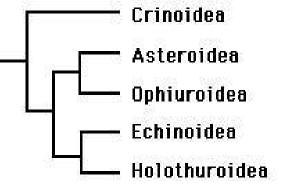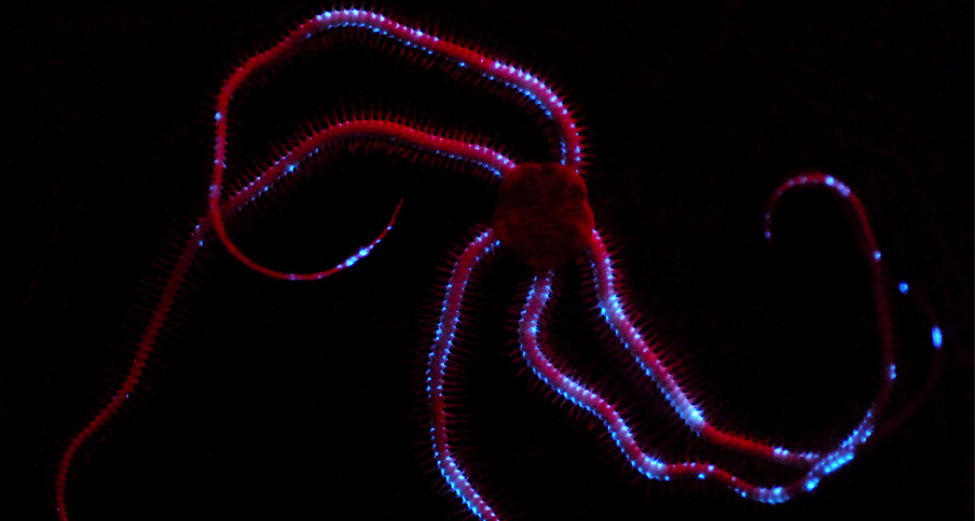Classification
Kingdom: Animalia
Phylum: Echinodermata
Class: Ophiuroidea
Order: Ophiurida
Family: Ophiocomidae
Genus: Ophiopsila
Species: riisei
The O. riisei brittle star is an animal just like a giraffe or panda!
Echinodermata
Phylogenetic tree:

The brittle star Ophiopsila riisei belongs to the phylum, Echinodermata. Some synapomorphies for organsims in this phylum include: a water vascular system, an endoskeleton made from calcium carbonate and proteins, a decentralized nervous system (Wray 1999), bilateral symmetry, and they are deuterostomes ('Assembling' 2013). Echinoderms share a most recent common ancestor with chordates, since Chordata is the only other phylum that consists of deuterostome organisms.
The echinoderm phylum consists of twenty one classes, but only five of those classes are extant. These extant classes include Crinoidea, Asteroidea, Ophiuroidea, Echinoidea, and Holothuroidea ('Assembling' 2013). The class Crinoidea contains organisms like sea lilies and feather stars. The class Asteroidea consists of starfish. The Echinoidea class has a variety of sea urchins, sand dollars, and sea biscuits. Holothuroidea is a class full of various sea cucumbers, including the species Holothuria pardalis and Stichopus chloronotus. Finally Ophiuroidea, the class that Ophiopsila riisei belongs to, consists of basket stars and brittle stars (Wray 1999).
Ophiuroidea
To see a phylogenetic tree of ophiuroids click here! (Shackleton 2005)
O. riisei is part of the Eophiura order of the above tree.
Ophiuroidea organisms are known by the common names brittle stars,
basket stars, and snake stars. The name Ophiuroidea comes from the Greek
words ophis, or snake, and oura, or tail, because of their long,
twisting arms. It has the most species (2,064) of any group of
echinoderms (Thuy et al. 2012). Usually an ophiuroid has five thin arms
coming out of a central disk (Hunter 2011). Many echinoderms use suction cups
on their tube feet, however, ophiuroids do not have these suction cups
so therefore their tube feet are seldom used for movement. They actually
transport themselves by swinging their flexible arms, using the surface
similar to a snake or grabbing matter and heave themselves ahead.
Ophiuroids have no anus and instead of having a plate on the dorsal
exterior like asteroids, ophiuroids use a madreporite, that is part of
the mouth, to join the water vascular system and the ocean. The number
of jaws in the mouth opening of the ophiuroid is determined by the
number of arms it has. Ophiuroids cannot eat mud like holothuoids,
asteroids, or echinoids can because they do not have an anus. Therefore,
they use different ways of eating like suspension-feeding or predation.
They have an esophagus and sac with ciliated epithelium (Thuy et al.
2012).
Ophiuroids fuse opposite arm plates with vertebrae unlike asteroids that have a closed channel. In the central disk are also genital slits which are the gaps between the genital sacs at the start of each arm. These are used to channel gametes or embryos. Brittle stars have bioluminescent characteristics because of photocytes when they feel provoked (Hunter 2011).
The way in which ophiuroids reproduce is also a synapomorphy to this class. See the reproduction page to learn about this!
For more information on ophiuroids visit these websites:
http://echinotol.org/ophiuroidea
http://www.ncbi.nlm.nih.gov/pmc/articles/PMC3292557/
To find out where Ophiopsila riisei can be found, see the Habitat page!
